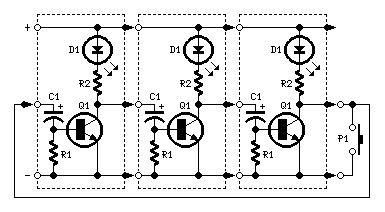Circuit diagram
parts list
R1______________68K 1/4W Resistor R2_______________2K2 1/4W Resistor R3______________56K 1/4W Resistor R4_______________3K3 1/4W Resistor R5,R6____________4K7 1/4W Resistors R7______________10K 1/2W Trimmer Cermet or carbon C1,C2___________22nF 63V Polyester Capacitors C3,C5__________100nF 63V Polyester Capacitors C4_______________1nF 63V Polyester or Ceramic Capacitor C6_____________220µF 25V Electrolytic Capacitor IC1,IC2_________7555 or TS555CN CMos Timer ICs IC3__________TDA7052 Audio power amplifier IC (See Notes) SPKR___________8 Ohm Loudspeaker (See Notes)
This circuit reproduces the sound of modern car horns. It was mainly designed for models and toys but, using a high output power audio amplifier IC, it can be used also in more demanding projects.
Circuit operation
To obtain a realistic car horn sound, two different tones mixed together are necessary and the interval they will form should be a so called minor third (in musical terms).This is implemented by two 7555 CMos Timer ICs wired as astable multivibrators and generating a square wave of about 440Hz and 523Hz respectively. These frequencies should be quite precise, so the uncommon values necessary for the timing resistors are obtained by wiring two standard value resistors in series.
The square wave frequencies generated by IC1 (440Hz) and IC2 (523Hz) are mixed through R5 and R6 and shaped by C3, C4 and R7 in order to obtain a more realistic tone. The resulting composite audio signal is finally sent to the audio power amplifier IC3 which, in turn, drives the loudspeaker. R7 should be adjusted to obtain a satisfactory output level.
Notes:
- The loudspeaker can be of any shape and diameter. Obviously it must
withstand a power of at least 1 Watt if the TDA7052 Audio power
amplifier IC is used.
In any case, try a good sized device, in order to obtain best results.















